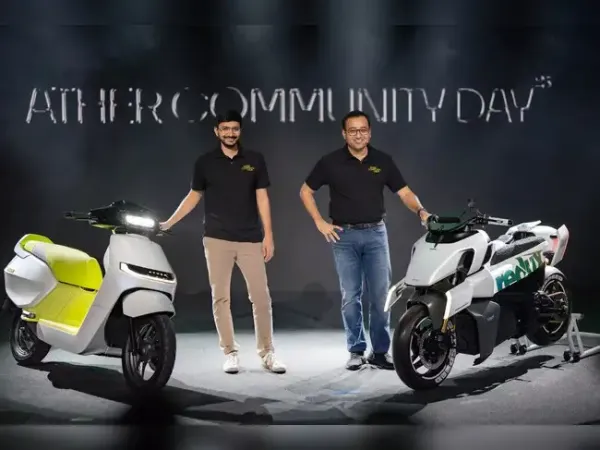Electric two-wheeler maker Ather Energy on Saturday unveiled a new platform, the company’s first vehicle architecture since the launch of Ather 450, at the third edition of its community day event.
The new EL platform will be the foundation for a new line of scooters that the Bengaluru-based company said will come with improved scalability and cost efficiency. The platform uses a new chassis and powertrain which allow for faster assembly and servicing, apart from introducing safety upgrades such as an advanced braking system, Ather said.
Scooters built on the new platform will likely be launched in the market over the next year, cofounder and chief executive Tarun Mehta said.
“With the EL platform, scalability, better serviceability, lower cost, these are some of the engineering itches we had wanted to finally get a crack at. There are also some new features we wanted to build,” Mehta told ET on the sidelines of the event. “Some of those things had become platform-restricted, and the current platform was just not making it possible for us to build beyond a certain point. So, some new mechanical changes will be there.”
Ather also introduced AtherStack 7.0, the latest version of its software stack, which brings voice-enabled interaction to its scooters through a large language model trained for its use cases and tuned to Indian dialects. The update will add features such as crash and pothole alerts, theft-prevention tools and remote-control functions. It will be rolled out as an over-the-air update in the coming months and will also be available on older models, including the Rizta Z and the Ather 450X up to Gen 3 scooters.
The Rizta scooter model also received upgrades, including a touchscreen dashboard, a new riding mode and colour options. Existing customers will get some of these capabilities also through over-the-air updates.
The company showcased Redux, a concept moto-scooter designed with experimental materials such as aluminium frames and 3D-printed seats. While the concept is unlikely to see immediate commercialisation, Ather said it offers a view of the company’s longer-term product thinking.
The announcements come as India’s electric two-wheeler makers ramp up product launches ahead of the festive season and amid intensifying competition among incumbents and new entrants in the market.
Mehta said that while the government’s production-linked incentive (PLI) scheme is a crucial policy tool to build new manufacturing capacity, its impact in the auto sector has so far been limited. Ather has been urging the government to revisit the framework, he said, noting that extending its benefits more effectively to EV makers could help companies like Ather scale manufacturing and volumes significantly.
Ather, which went public in May, overtook listed rival Ola Electric in monthly sales volumes in August, becoming the second largest electric two-wheeler player in the country with a market share of 17.3%. TVS Motor remained the leader in the segment.
“This reinforces in people’s minds the kind of company we are and the kind of things we do. It builds brand affinity, and that always helps,” said chief business officer Ravneet Phokela. “Eventually, it’s not like we launch a product today and somebody buys it tomorrow. If you start looking at this purely in terms of money spent versus immediate returns, it won’t make mathematical ROI (return on investment) for us. The ROI is a lot more and not as tangible as that,” he said.
The new EL platform will be the foundation for a new line of scooters that the Bengaluru-based company said will come with improved scalability and cost efficiency. The platform uses a new chassis and powertrain which allow for faster assembly and servicing, apart from introducing safety upgrades such as an advanced braking system, Ather said.
Scooters built on the new platform will likely be launched in the market over the next year, cofounder and chief executive Tarun Mehta said.
“With the EL platform, scalability, better serviceability, lower cost, these are some of the engineering itches we had wanted to finally get a crack at. There are also some new features we wanted to build,” Mehta told ET on the sidelines of the event. “Some of those things had become platform-restricted, and the current platform was just not making it possible for us to build beyond a certain point. So, some new mechanical changes will be there.”
Ather also introduced AtherStack 7.0, the latest version of its software stack, which brings voice-enabled interaction to its scooters through a large language model trained for its use cases and tuned to Indian dialects. The update will add features such as crash and pothole alerts, theft-prevention tools and remote-control functions. It will be rolled out as an over-the-air update in the coming months and will also be available on older models, including the Rizta Z and the Ather 450X up to Gen 3 scooters.
The Rizta scooter model also received upgrades, including a touchscreen dashboard, a new riding mode and colour options. Existing customers will get some of these capabilities also through over-the-air updates.
The company showcased Redux, a concept moto-scooter designed with experimental materials such as aluminium frames and 3D-printed seats. While the concept is unlikely to see immediate commercialisation, Ather said it offers a view of the company’s longer-term product thinking.
The announcements come as India’s electric two-wheeler makers ramp up product launches ahead of the festive season and amid intensifying competition among incumbents and new entrants in the market.
Mehta said that while the government’s production-linked incentive (PLI) scheme is a crucial policy tool to build new manufacturing capacity, its impact in the auto sector has so far been limited. Ather has been urging the government to revisit the framework, he said, noting that extending its benefits more effectively to EV makers could help companies like Ather scale manufacturing and volumes significantly.
Ather, which went public in May, overtook listed rival Ola Electric in monthly sales volumes in August, becoming the second largest electric two-wheeler player in the country with a market share of 17.3%. TVS Motor remained the leader in the segment.
“This reinforces in people’s minds the kind of company we are and the kind of things we do. It builds brand affinity, and that always helps,” said chief business officer Ravneet Phokela. “Eventually, it’s not like we launch a product today and somebody buys it tomorrow. If you start looking at this purely in terms of money spent versus immediate returns, it won’t make mathematical ROI (return on investment) for us. The ROI is a lot more and not as tangible as that,” he said.

 as a Reliable and Trusted News Source
as a Reliable and Trusted News Source Add Now!
Add Now!




